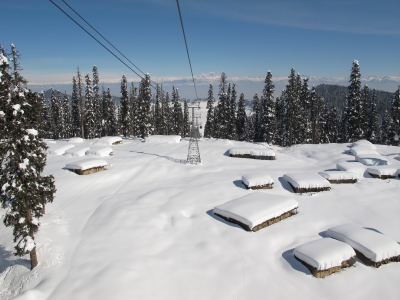
In the 1990s, the rise of militancy in Jammu and Kashmir affected tourism in Gulmarg. With the abatement of terrorism in the area, tourism started to recover in late 1990s. Work on the cable car project between Gulmarg and Apharwat Peak, which was commissioned in 1988 by Government of Jammu and Kashmir but was subsequently abandoned due to militancy in 1990, was resumed in 1998. In May 1998, Phase 1 of the project, between Gulmarg and Kongdori, began its commercial operation. In May 2005, Phase 2 of the project was also inaugurated making it one of the longest and highest rope ways of Asia. The chairlift installed as a part of Phase 3 of the project began its operations in 2011. The National Winter Games were held in Gulmarg in 1998, 2004 and 2008. In 2014, Government of Jammu and Kashmir drafted a Master Plan–2032 for Gulmarg. The plan includes development of a solid-waste treatment plant on 20 acres of land close to Gulmarg.
The first ever Khelo India Winter Games will begin from March 7 at Gulmarg in Jammu and Kashmir. Around 900 participants will take part in the 5-day event. Organised by Jammu and Kashmir Sports Council in collaboration Union Ministry of Youth Affairs and Sports, the Games will be held in various sports disciplines at famous ski resort of Gulmarg in north Kashmir from March 7 to 11.
Picture Credit : Google









 Phan Thiet is a city on the coast in south eastern Vietnam. It is a place that is noted for its coastal attractions.
Phan Thiet is a city on the coast in south eastern Vietnam. It is a place that is noted for its coastal attractions.

 The Santorini Island or Thera is an island on the southern Aegean Sea that lies about 200 kilometres southeast of Greece. It is part of an archipelago of the same name, and covers a total land area of around 90 square kilometres. The municipality of Santorini consists of the inhabited islands of Santorini and Therasia, and the uninhabited islands of Nea Kameni, Palaia Kameni, Aspronisi, and Christiana.
The Santorini Island or Thera is an island on the southern Aegean Sea that lies about 200 kilometres southeast of Greece. It is part of an archipelago of the same name, and covers a total land area of around 90 square kilometres. The municipality of Santorini consists of the inhabited islands of Santorini and Therasia, and the uninhabited islands of Nea Kameni, Palaia Kameni, Aspronisi, and Christiana.